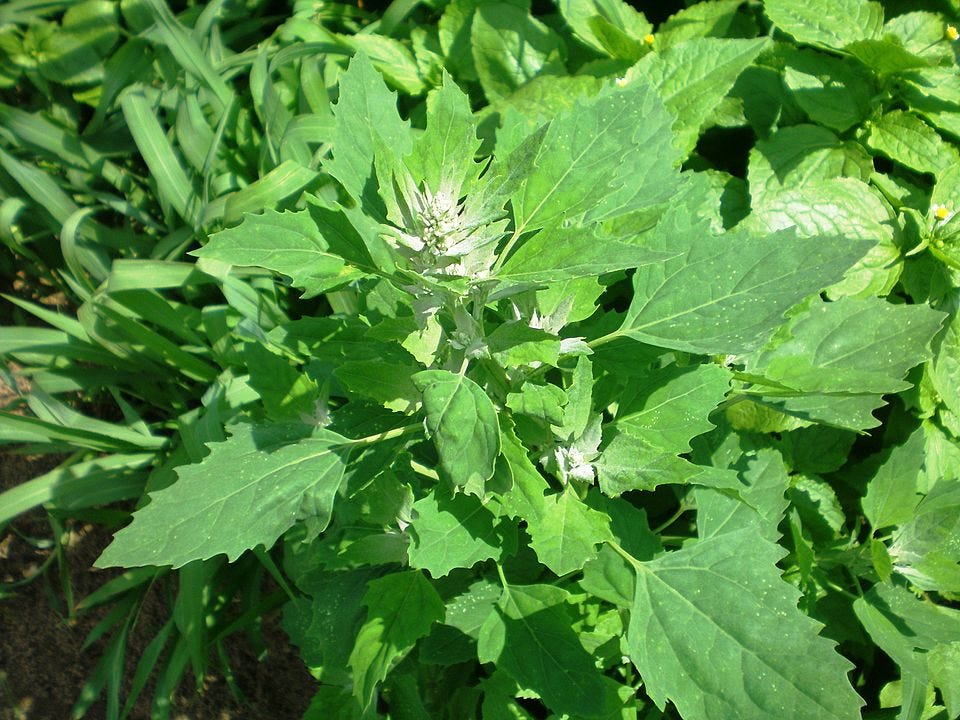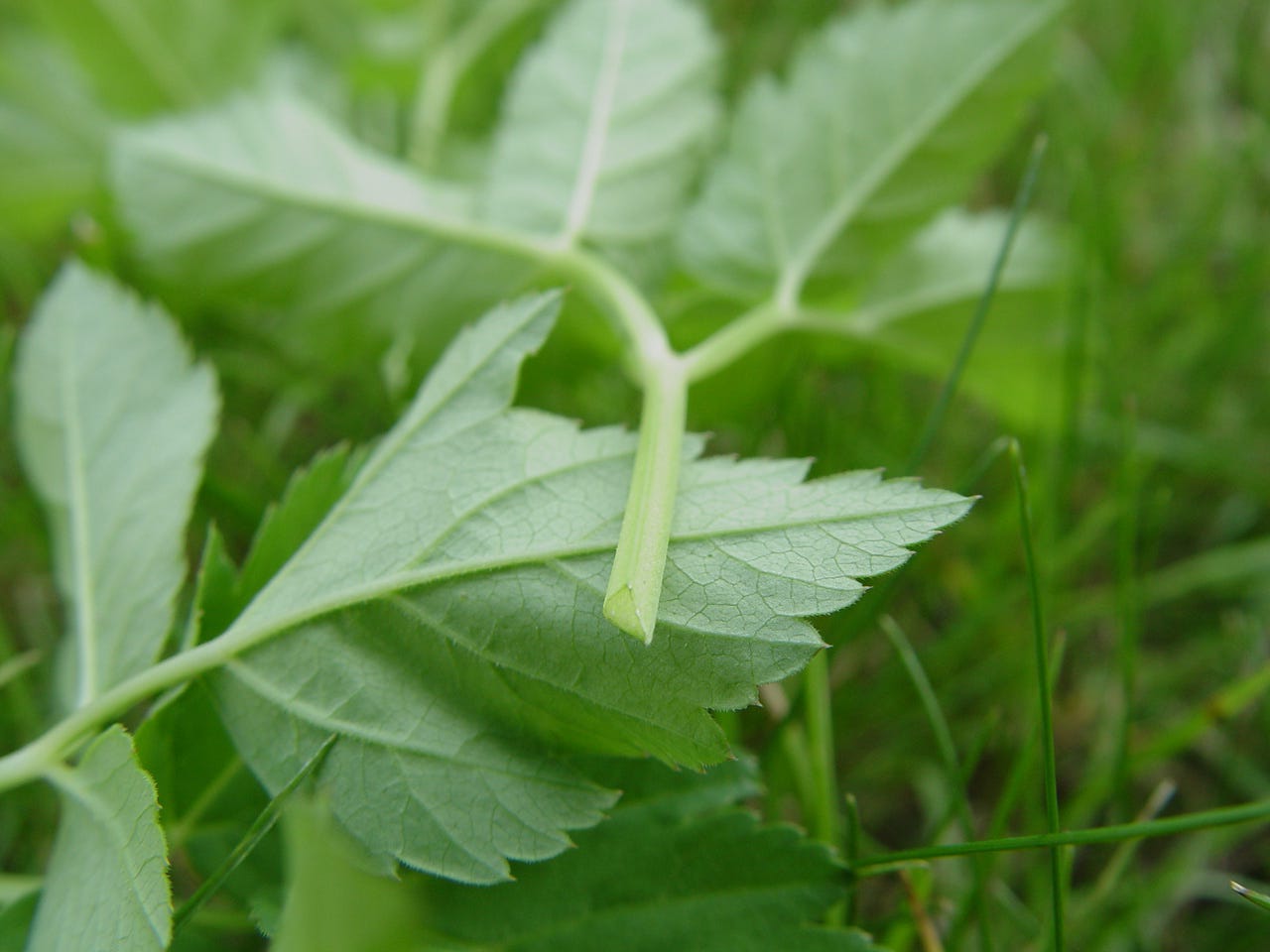
Known as the ‘weeds of cultivation’, arable or garden weeds, some people spend a lot of time and effort eradicating edible weeds to replace them with vegetables. Nowhere is the irony more amusing than in growing salads! The following ten plants will all invite themselves onto your patch of soil and can be harvested for food instead of just weeded out and discarded.
1. Chickweed Stellaria media. It’s seems that wherever you’ve bared the soil, chickweed will be in like a shot to cover it up again. It spreads over the surface of the soil putting down very fine roots as it goes. It is the forager’s ‘iceburg lettuce’! By this I mean that it has a very fresh, cool taste - reminiscent of cucumber and spinach - so it works very well as a salad base when combined with some of the more pungent or bitter wild herbs. The leafy tops are the best part to gather as it can get a little stringy as it spreads and ages. Popular dishes include Chickweed Pakora and Chickweed Soup. Medicinally it is considered cooking for hot, re inflammation - so useful for eczema and nappy rash.
2. Hairy bittercress Cardamine hirsuta and its slightly larger cousin, Wavy bittercress Cardamine flexuosa. Bittercress has an explosive seed mechanism by which seeds can be shot out up to 1m (3ft) away. If the wind catches them they’ll go even further! This means that it gets everywhere with several sprouting a year. It likes bare soil beds, gravelly paths and even city pavements. Bittercresses grow as a rosette of leaves looking like miniature watercress and they have a similar hot, peppery taste. In early summer they put a single flowering stem with a spray of tiny white four petalled flowers. Use them to spice up a salad or in a hot green pesto.
3. Fat hen Chenopodium album also called Lambs-quarters or White goosefoot is in the family Amaranthaceae. So it’s related to amaranth and quinoa, commonly bought grains that are available in many supermarkets now. The leaves are quite variable in shape but distinctively coloured - green on top and silvery white below and covered in a mealy bloom. The leaves have a spinach like flavour, spinach is another relative, and can be used in the same way as spinach. the fleshy seeds can be collected and used as a native quinoa with no food miles. Lightly steam the leaves and add a little olive oil or butter. They are delicious.

Fat Hen (see notes for image credit)
4. Cleavers Galium aparine. Twining, climbing and tumbling over your plants when your back is turned, cleavers is related to your morning cup of coffee. It has many common names including Goosegrass, Love Hearts and Sticky Willie. It is covered in hooked hairs that help it climb but also make it stick to animal fur and clothes. The simplest way to use Cleavers is a cold infusion made by picking a small handful of young shoots and putting them into a jug of cold water to infuse overnight. Drink in the morning for a refreshing coconutty-cucumbery tasting pick me up. It acts on the lymphatic system so is a very useful detox and diuretic - great if you ever get swollen ankles or fluid retention. In the Spring, the young tips can be added to salads. When it is larger I also like to juice it in my wheatgrass juicer and add a shot to apple juice.
5. Dandelion Taraxacum officinale. A multi-purpose food crop, the dandelion offers all of its parts except the stem and calyx as food. In fact, all cookery books up until 1900 invariably included a recipe for dandelion salad. There are about 290 varieties of dandelion in the UK, each adapted to a different habitat, so you can find them almost everywhere. The leaves are bitter and can be used like rocket mixed into a salad of milder greens. If you put a flower pot over them in the Spring you will prevent the leaves from getting light and this makes them less bitter. The first year roots can be boiled and eaten with carrots, or roasted with parsnips trimmed to a similar size. Drizzle over a little olive oil, a trickle of maple syrup, grated Parmesan and some black pepper and you have one of my favourite dishes. Older roots can be roasted until they are dark brown and snap between your fingers. Then ground and boiled to make a great (decaf) alternative to coffee.
6. Ground elder Aegopodium podagraria. So many people are locked into a permanent battle with ground elder without realising how useful it is. Introduced by the Romans as a kitchen herb, it has a mild taste that is a mixture of its close relatives parsley and celery. I use big handfuls to flavour soups and stews in place of parsley. The young bright green shoots make a great base for a salad. You can chop it finely and add it to a huge range of dishes from omelettes to mashed potato. Choose the young, shiny bright-green leaves for the best flavour. The older leaves are more fibrous and can’t be eaten once the plant has flowered. If everybody who grumbled about ground elder gave up their garden poisons and started harvesting it instead, it would help to keep it under control and become a valuable friend rather than an enemy!
Ground Elder (see notes for image credit)
7. Daisy Bellis perennis. Hate them if you want a perfect, bowling-green lawn but love them if you like a cheeky face. Daisies can be found flowering all year round and both the leaves and flowers are edible. Add them to your salad leaves. I use them to decorate little puddings. I leave a little bit of stalk on them and push them into pannacottas. When put in the fridge they close up, but when brought back out in the light again they open up, much to the delight of the recipient. Daisy leaves can also be used as a good alternative to arnica. Soak the leaves in vegetable oil for a few weeks and then add 30% melted beeswax to make a simple salve. Great for bumps, bruises and other household emergencies.
8. Nettle Urtica dioica. If nettles only grew in the Amazon we’d be flying them in as a superfood! Nettle is a European superfood. They grow on rich disturbed soil around houses and farm yards and in parks. They are a rich source of minerals such as magnesium, iron, calcium and silica so especially help to keep bone, skin and hair strong. They are high in vitamins A, Bs and C. They are high in protein. Pick the young shoot tops to cook as rich earthy vegetable in spring. I always tell people that you can use it exactly as you’d use spinach - except for eating it raw! You are limited only by your imagination. Collect the plump seeds in late summer and toast them to bring out their nutty, hempseed-like flavour and add them to bread or oat cakes when you’re baking. Or grind the green seeds and soak them in a little vodka for a month. Then use this tincture a teaspoonful at a time as a winter blues pick-me-up.
9. Sorrel Rumex acetosa and Sheep’s sorrel R. acetosella but not its cousin broad-leaved dock. Sorrel is a common herb of any grassland and tolerates mowing and grazing. The distinctive leaves are arrow shaped with backward pointing spurs. Sorrel is rich in acetic acid giving the whole plant a refreshing lemony zing. It can be nibbled on raw, added to salads or used as a garnish. Wilted over stock with some fried onions and blitzed together it makes an excellent Sorrel Sauce to use with fish - or any oily or fatty dish.
10. Japanese knotweed Fallopia japonica is not a very common weed any more - as it’s usually aggressively eradicated - but I wanted to include it to show you that even an invasive species can be hugely useful. It’s a controlled plant by law so you must never contribute to its propagation - so no scraps or cut ends put into your bin or compost. The young pink-purple spears are harvested in the spring and taste very much like rhubarb. They can be cooked with apple or sweet cicely in a crumble, lightly stewed, turned into jam or even fermented into wine. It contains a very high level of resveratrol, an anti inflammatory also found in grapes, blueberries and raspberries. I use a lot of the root in my Lyme disease clinic as, not only is it helpful for joint pain and arthritis-like symptoms, but it has also been proved to be a good antibiotic against Borrelia infection. An invasive plant coming to the rescue for an ever-more invasive disease. I am always full of gratitude for the plants!
Japanese Knotweed (see notes for credit)
Sadly, having limited myself to only 10 edible weeds, plantain, thistles, fish mint and couch grass will have to wait until another day. But don’t take your weeds for granted in the meantime. Don’t just weed them out and throw them away. Learn their names and more about them, in a crazy Covid, post-Brexit world you may be very grateful for them! #eattheweeds
More information to visit our Herbalist
***Content of this blog/website is for information purpose only. It is not intended to substitute for legal or medical advice, or medical treatment or diagnosis. Consult your health care provider if you are experiencing any symptoms and before using any herbal product or beginning a new health regimen. When wildcrafting or foraging for plants, do so ethically; be accompanied by an expert; and always have absolute certainty of plant identification before using or consuming any herbs. by using any or all of this information, you do so at your own risk. No warranties are expressed or implied. Any application of the material provided is at the reader’s discretion and is his or her sole responsibility.


